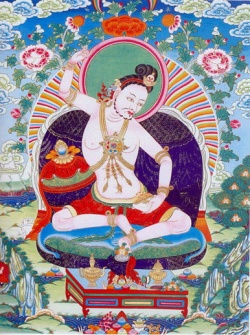Difference between revisions of "Annotations on the Mahavairochana Sutra"
(Created page with "thumb|250px| <poem> Annotations on the Meaning of the Lotus Sutra 法華義疏 (1) (Chin Fa-hua-i-shu; Jpn Hokke-gisho ) A twelve-vo...") |
|||
| Line 1: | Line 1: | ||
[[File:23 5.JPG|thumb|250px|]] | [[File:23 5.JPG|thumb|250px|]] | ||
<poem> | <poem> | ||
| − | [[Annotations on the | + | [[Annotations on the Mahavairochana Sutra]] |
| − | [[ | + | [[大日経疏]] (Chin [[Ta-jih-ching-shu]]; Jpn [[Dainichi-kyo-sho]] ) |
| − | + | ||
| + | A compilation by [[I-hsing]] (683-727) of the lectures [[Shanwuwei]] (Skt [[Shubhakarasimha]]) gave on the [[Mahavairochana Sutra]]. After [[Shanwuwei]] translated the [[Mahavairochana Sutra]] into {{Wiki|Chinese}} in 725, he lectured on this [[sutra]] to his [[disciple]] [[I-hsing]], who in turn recorded the teacher's lectures. After [[I-hsing's]] [[death]], [[Chih-yen]] and [[Wen-ku]] revised the commentary and titled their work The [[Commentary on the Meaning of the Mahavairochana Sutra]]. In [[Japan]], The [[Annotations on the Mahavairochana Sutra]], which was brought to [[Japan]] by [[Kobo]], became the textbook of [[True Word]] ( Jpn [[Shingon]]) [[Esotericism]], while The [[Commentary on the Meaning of the Mahavairochana Sutra]], which was brought by [[Jikaku]] and [[Chishoof]] the [[Japanese]] [[Tendai]] school, became the textbook of [[Tendai]] [[Esotericism]]. | ||
| + | |||
| − | |||
| − | |||
</poem> | </poem> | ||
{{R}} | {{R}} | ||
Latest revision as of 03:02, 2 October 2013
Annotations on the Mahavairochana Sutra
大日経疏 (Chin Ta-jih-ching-shu; Jpn Dainichi-kyo-sho )
A compilation by I-hsing (683-727) of the lectures Shanwuwei (Skt Shubhakarasimha) gave on the Mahavairochana Sutra. After Shanwuwei translated the Mahavairochana Sutra into Chinese in 725, he lectured on this sutra to his disciple I-hsing, who in turn recorded the teacher's lectures. After I-hsing's death, Chih-yen and Wen-ku revised the commentary and titled their work The Commentary on the Meaning of the Mahavairochana Sutra. In Japan, The Annotations on the Mahavairochana Sutra, which was brought to Japan by Kobo, became the textbook of True Word ( Jpn Shingon) Esotericism, while The Commentary on the Meaning of the Mahavairochana Sutra, which was brought by Jikaku and Chishoof the Japanese Tendai school, became the textbook of Tendai Esotericism.
